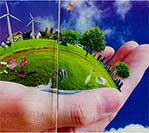WHAT can we do today for a better world in 2030? What are the development goals that will chart a path to a future that we all want?
These are the lofty questions that are being asked at the United Nations in charting out a new development path that addresses the challenge of pursuing human development in a finite world.
The need for a new global development agenda arose as we enter the final sprint towards the Millennium Development Goals (MDGs). Established in 2000, it formed a blueprint for global development to be achieved by 2015.
The MDGs brought about remarkable achievements. Half a billion fewer people now live in extreme poverty, a record number of children are attending primary school, access to safe water has increased, and the list goes on. It was hailed as a testament to international cooperation, where a universal agenda can play an instrumental role in solving the world’s most pressing problems.
Despite its achievements, many challenges remain and have emerged since.
More than one billion people continue to live in extreme poverty, with inequality rising. The world is more crowded, with 7.2 billion people and counting. The impacts of environmental degradation are being felt, imposing limits to exploitation of natural resources.
The world is getting smaller and more interconnected through trade networks, finance, technologies, migration, and social networks.
In response, world leaders called for a new global partnership to build upon the MDGs. Recognising the need to integrate social, economic and environmental goals, a report by the High-Level Panel of eminent persons last year called for sustainable development to be put at the core of the post-2015 development agenda.
At the UN General Assembly in September, the world’s nations agreed that a set of proposed Sustainable Development Goals (SDGs) — ranging from socio-economic goals, such as poverty eradication, equity, education and health, to environmental goals, such as combating climate change and biodiversity conservation — would be the main basis for a truly transformative global development agenda beyond 2015. The SDGs will be negotiated and finalised next September.
While the pursuit of sustainable development has gained momentum, mainstreaming the appropriate actions will be a monumental challenge. Globally, this will largely depend on the means of implementation, where mechanisms on trade, finance, capacity building and technology transfer will test the global partnership’s commitment to the agenda. Perhaps more crucially, nationalising the SDGs — how nation states adopt and adapt the goals to meet their aspirations — will be at the frontier in realising the goals.
For Malaysia, the first question to ask is its relevance to our aspirations. The SDGs are designed to be universal — relevant to all, including both developing and developed countries. While some goals, such as eradicating extreme poverty and ending hunger, are virtually achieved, other goals, such as the various environmental goals and reducing inequalities, are still very relevant.
Secondly, while the SDGs cover a wide spectrum of economic, social and environmental goals, it does not highlight the trade-offs nor the synergies between them. The tough question on how to balance economic growth with environmental protection is not addressed.
It is incumbent upon each nation to define their own pathways to find a “win-win situation” and turn the risks into opportunities.
While this systemic way of thinking has often been an intellectual pursuit, the SDGs should catalyse practical solutions towards a more productive, inclusive and green economy. Moving from theory to practise will require transformative policies, institutions and modes of governance.
Thirdly, the monitoring of the SDGs — with no less than 169 targets identified — will require a data revolution. Targeting all relevant groups, data is required at the disaggregated level, requiring a concerted effort in building adequate capacity. The recent announcement by Prime Minister Datuk Seri Najib Razak to overcome the skills gap in terms of data scientists through the Big Data Analytics initiative is timely.
Ultimately, the success of the SDGs will be judged by its impact on improving the everyday lives of the general public.
At a time when the world is becoming increasingly uncertain, with the resurgence of extremism and terrorism, a sluggish economy and “on the ground” issues, such as rising living costs often taking precedence over long-term aspirations, global ideals may not be the priority of decision makers nor the general public.
An increased leaning towards political tribalism and extreme ideologies can serve to diminish the perceived urgency of more lofty and aspirational goals.
These inconvenient truths will not go away and are only likely to be exacerbated if ignored. With 400,000 protesters marching the streets of New York in September to demand action towards the quintessential sustainable development challenge of climate change, there are signs that the agenda has made inroads into the hearts and minds of the general public.
Next year will usher in what some term an age of sustainable development. Coinciding with Malaysia securing a seat on the UN Security Council and our chairmanship of Asean, the SDGs will be an opportunity for Malaysia to demonstrate our global leadership in pursuing a new paradigm in development that benefits all and for generations to come.
This article first appeared in The New Straits Times on 11 November 2014





